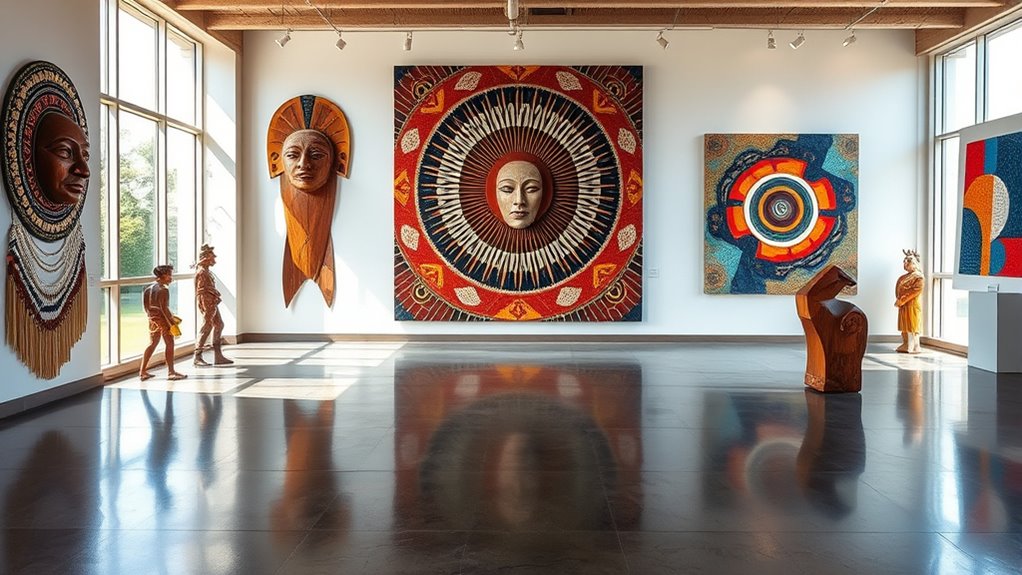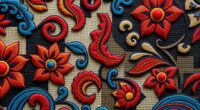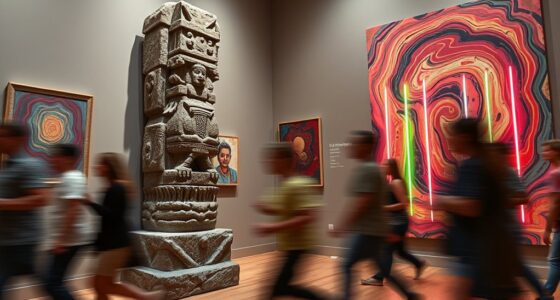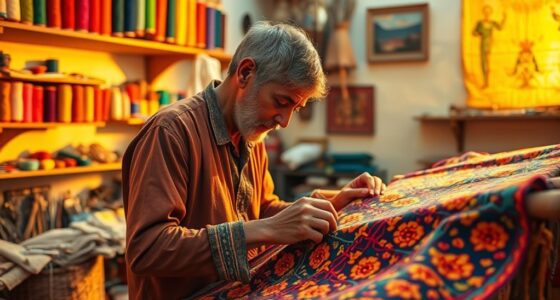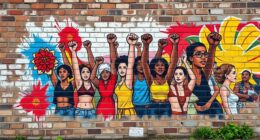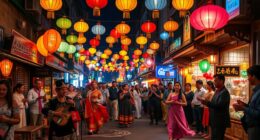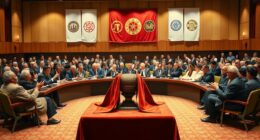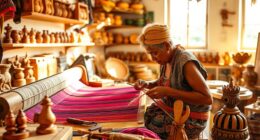Indigenous art now plays a prominent role in contemporary galleries, blending traditional techniques with modern media to showcase cultural resilience and innovation. Major exhibitions highlight Indigenous creators’ stories, boosting their global visibility and market value. Artists incorporate contemporary materials, digital technology, and multimedia to express heritage and new ideas. If you keep exploring, you’ll discover how technology and evolving curatorial practices are shaping this dynamic, artful fusion of tradition and modernity.
Key Takeaways
- Indigenous artworks are increasingly featured in mainstream galleries, blending traditional techniques with contemporary artistic expressions.
- Artists incorporate modern materials and digital media to reinterpret ancestral stories and cultural symbols.
- Collaborations with Indigenous communities ensure authentic representation and respect for cultural significance.
- Technology like AI and digital platforms expand Indigenous art visibility, fostering cultural preservation and audience engagement.
- Exhibitions highlight the resilience and diversity of Indigenous cultures, showcasing the fusion of tradition and innovation.
The Rising Visibility of Indigenous Art in Major Exhibitions

The visibility of Indigenous art in major exhibitions has surged in recent years, reflecting a significant shift in the art world’s recognition of Indigenous creators. Now, Indigenous works occupy prime gallery spaces and tour internationally, a stark contrast to past marginalization. For example, the Denver Art Museum hosts a prominent Indigenous art survey that emphasizes resilience and diversity through 2025. The National Gallery of Art in Washington is preparing for “The Stars We Do Not See,” the largest-ever Australian Indigenous art exhibition to tour North America, opening in October 2025. Major U.S. institutions like the Block Museum, Hood Museum, and Zimmerli Art Museum are also featuring Indigenous-focused shows. This expanded presence signals a broader acknowledgment of Indigenous creativity, elevating their voices in the contemporary art landscape. This growing visibility demonstrates the ongoing efforts of museums and galleries to showcase Indigenous perspectives and honor their cultural contributions, as well as the importance of creative practice in fostering cultural resilience and representation.
Shifting Institutional Perspectives and Recognition
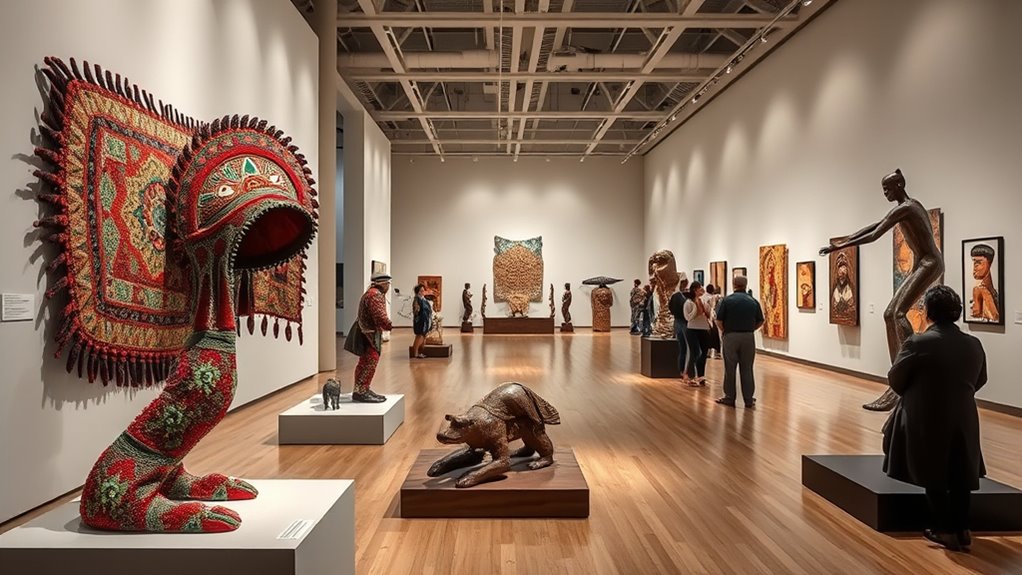
As awareness of Indigenous contributions grows, museums are beginning to reevaluate their roles in shaping representation and inclusivity. You should know that only 1% of U.S. museum staff are Native American, highlighting the need for greater Indigenous involvement. In response to protests, many institutions are reexamining their exhibition practices and forming partnerships with tribal nations to prioritize Indigenous perspectives. Compliance with NAGPRA has become essential, ensuring tribes are notified and involved in decisions about Indigenous artifacts. Despite these efforts, challenges remain, including ongoing violations and resistance from some institutions. Increasing collaboration with Indigenous consultants and establishing community-led initiatives are crucial steps toward restoring trust, recognizing Indigenous art, and advancing equitable relationships. Efforts to increase Indigenous curators and leadership These changes mark a significant shift in how museums approach Indigenous representation. Additionally, addressing the representation gap in museum staffing and leadership is vital for authentic engagement and cultural preservation. Furthermore, promoting cultural competency among museum staff can foster more respectful and accurate portrayals of Indigenous histories and art. Recognizing the importance of Indigenous-led initiatives can further ensure that Indigenous voices shape the narrative and display of their cultural heritage. Moreover, expanding the use of self-watering plant pots in museum gardens can support sustainable practices and reduce maintenance efforts, aligning with environmental stewardship goals. Recognizing and incorporating diversity in museum staffing is also essential for meaningful change and authentic storytelling.
Blending Traditional Crafts With Contemporary Media

Indigenous artists seamlessly blend traditional crafts with contemporary media, creating works that honor ancestral techniques while embracing modern materials. You see woven baskets with synthetic fibers, paintings using acrylics over traditional symbols, and sculptures combining animal skins with industrial metal. This fusion highlights cultural continuity and adaptability, showing how traditions evolve with new influences. Incorporating predictive analytics can further support artists in understanding audience preferences and market trends. This technological integration demonstrates how artistic innovation can bridge past and present. Through these hybrid forms, you witness storytelling, social commentary, and cultural pride, all expressed via innovative techniques that keep Indigenous traditions alive and relevant today.
Market Dynamics and Collectors’ Growing Interest
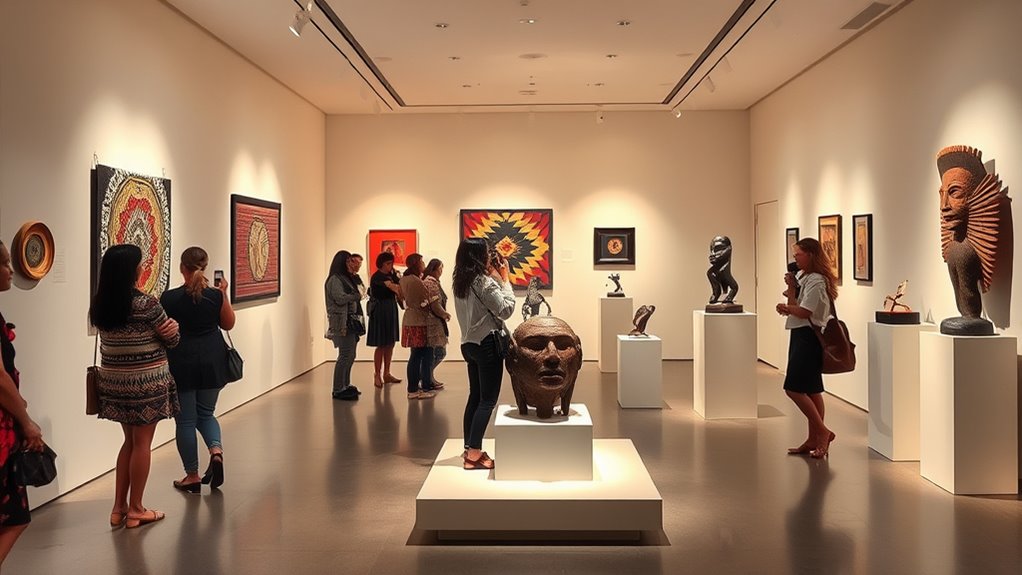
As your interest in Indigenous art grows, you’ll notice collectors are becoming more discerning, seeking pieces with authentic stories and cultural significance. This increased demand is steadily boosting market values and elevating the visibility of Indigenous artists. With more collectors investing in diverse and meaningful works, the market continues to expand and gain recognition. Digital expansion and online sales strategies are also helping to increase accessibility and awareness of Indigenous artworks globally, especially as market dynamics evolve to accommodate changing collector preferences. Additionally, art market trends are showing a growing appreciation for traditional techniques blended with contemporary expressions, which further enhances the importance of understanding cultural authenticity in art valuation.
Rising Collector Demand
Growing collector interest in Indigenous art has markedly reshaped the market landscape, driven by increasing demand for rare and high-quality works. You now see a focus on early Papunya and Pintupi pieces from the 1970s–80s, with works by Rover Thomas and Emily Kame Kngwarreye highly sought after. Bark paintings from Arnhem Land and rare sculptures are entering prestigious collections worldwide.
| Collector Priorities | Market Trends |
|---|---|
| Quality & provenance | Preference for museum-quality works |
| Rarity & cultural significance | Premium prices for exceptional pieces |
| Discerning acquisition strategies | Growth in online sales channels |
| Digital engagement | Younger, diverse collector base |
| Institutional recognition | Works entering major private and public collections |
Market Valuation Growth
Have you noticed how the valuation of Indigenous art is soaring worldwide? This growth stems from rising global interest rooted in cultural diversity and historical significance. Recent art market reports show Indigenous pieces are increasingly integrated into mainstream collections, with some artworks becoming trendsetters that command high prices at auctions. The cultural importance of these works amplifies their value, as collectors seek pieces with deep symbolic meaning. Additionally, the art market’s resilience during economic uncertainties supports this upward trend. Trends like the revival of traditional media and a focus on diversity further boost demand. As economic stability in key markets grows, so does the investment potential of Indigenous art. Collectors recognize its cultural richness and long-term appreciation prospects, fueling its expanding market valuation. Furthermore, the safety features of modern art preservation techniques help maintain the integrity and longevity of these culturally significant pieces, ensuring their value continues to grow over time. The integration of cultural preservation strategies also plays a crucial role in sustaining the cultural significance and market appeal of Indigenous artworks. This ongoing commitment to cultural heritage and the use of advanced preservation techniques enhances both the intrinsic and market value of these pieces, attracting new generations of collectors and institutions eager to support authentic cultural expressions. Moreover, understanding traditional art forms is essential for appreciating the depth and authenticity of Indigenous artworks, which further elevates their desirability among discerning collectors.
Prominent Artists Shaping the Contemporary Indigenous Scene
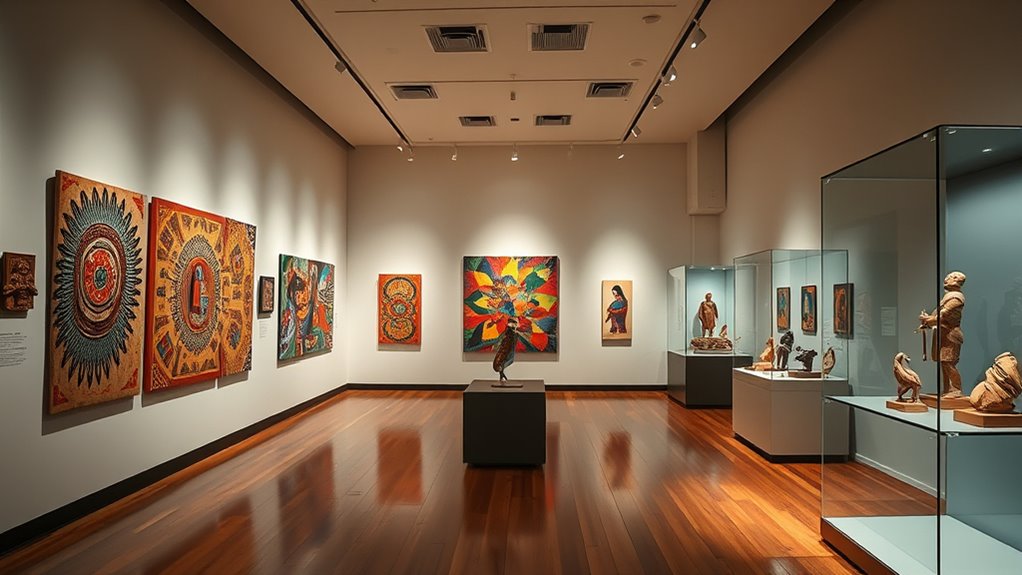
Contemporary Indigenous art is shaped by a dynamic group of artists whose work reflects cultural stories, land connections, and innovative techniques. You see their influence across galleries worldwide, each bringing unique perspectives. Louise Numina’s vibrant landscapes depict ancestral stories, while Karen Lee Mungarrja’s deep land connections shape her art. Renee Clifton blends traditional practices with modern styles, honoring her mixed heritage. Gidabul Doobay shares family stories, fostering cultural pride through community projects. Sebastian Gaskin’s recent award highlights emerging talent. Visualize their work: Networking and collaborations are key to expanding their reach and influence. However, the integration of new payment technologies involves potential pitfalls, requiring careful management to ensure success.
Technology’s Role in Curating and Presenting Indigenous Works
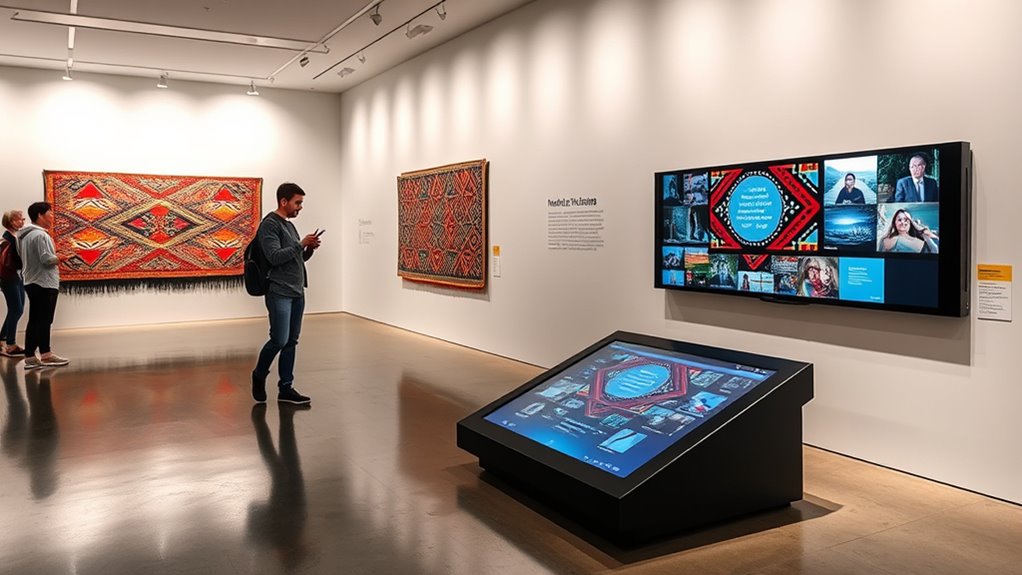
Technology is transforming how you curate and present Indigenous art, offering tools like AI for analysis and enhancement. Digital platforms expand access, making Indigenous works more visible worldwide while supporting authentic representation. By leveraging these innovations, you can guarantee respectful, accurate portrayals that honor cultural protocols and community voices. Additionally, integrating AI security measures ensures that sensitive cultural data remains protected against cyber threats, maintaining trust and integrity in digital exhibitions. Incorporating body awareness techniques can further enhance how viewers connect with Indigenous artworks by fostering a deeper understanding of their cultural significance. Emphasizing cultural protocols in digital presentations helps uphold the integrity and authenticity of Indigenous art.
AI-Enhanced Curatorial Analysis
AI is transforming how museums curate and present Indigenous artworks by analyzing vast datasets to identify meaningful themes, connections, and narratives. You can explore AI-driven exhibitions that suggest themes, artworks, and interpretive texts, as seen at the Nasher and Helsinki Art Museum. Custom-trained AI interfaces organize and narrate exhibitions, highlighting patterns that might take years for humans to discover. However, AI can sometimes challenge cultural sensitivity, leading to mismatched selections. Additionally, AI provides alternative perspectives, offering innovative ways to catalog and interpret collections.
- Analyzes large datasets for thematic insights
- Highlights hidden connections among artworks
- Supports immersive digital experiences
- Balances data-driven analysis with cultural integrity
Digital Platforms Expansion
Digital platforms are revolutionizing how Indigenous artworks are curated and experienced, making cultural heritage more accessible and engaging than ever before. TikTok, for instance, helps Indigenous artists connect with wider audiences, fostering community involvement through relatable content. Platforms like the Virtual Platform for Indigenous Art (VPIA) bridge communities and institutions, offering access to traditional knowledge and artworks. Interactive digital galleries create immersive experiences, supporting cultural preservation and equity by allowing users to explore Indigenous art in innovative ways. The VPIA combines community-generated content with institutional records, promoting collaboration and authenticity. With significant funding from Digital Museums Canada, these digital initiatives assure long-term preservation, expand economic opportunities for artists, and amplify Indigenous voices globally. This expansion transforms how Indigenous art is shared, appreciated, and preserved in the digital age.
Authentic Representation Strategies
As Indigenous artists and communities take control of how their work is shared, they increasingly use innovative tools to guarantee authenticity and respect cultural protocols. Technology helps certify their stories and cultural expressions remain true to their origins. You’ll see digital media amplifying Indigenous narratives, allowing artists to share histories, cosmologies, and traditions directly. Multimedia installations blend past and present through video, sound, and digital projections, creating immersive experiences. Interactive digital art, like AR and VR, fosters deeper community engagement and dialogue. Additionally, digital platforms enable artists to control how their work is presented and who accesses sacred content. Collaboration with Indigenous technologists further certifies cultural integrity, helping preserve language, guarantee respectful representation, and reinforce community ownership in digital spaces.
- Digital curation maintains community oversight
- Cultural protocols embedded in platforms
- Customizable archives safeguard traditions
- Controlled access protects sacred content
Celebrating Heritage While Embracing Artistic Innovation
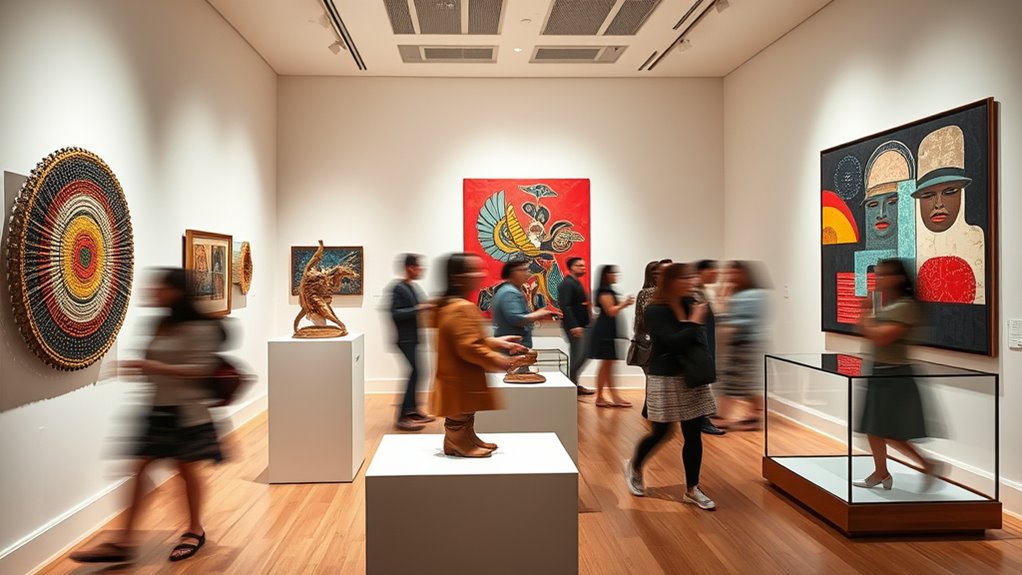
Indigenous artists are increasingly blending traditional techniques with contemporary themes, creating works that honor heritage while pushing creative boundaries. You’ll see artists incorporate textile art, ceramics, and video, merging age-old craftsmanship with modern forms. This approach keeps cultural narratives alive, often shared through family and community teaching, ensuring continuity and innovation. Exhibitions highlight how Indigenous art challenges and redefines identity, reflecting current realities alongside historic stories. Artists like Jeffrey Gibson use vibrant mixed media to connect personal and cultural histories, engaging contemporary audiences. Collectors value tactile, labor-intensive works, boosting the market for Indigenous textiles and ceramics. Major institutions now feature Indigenous artists in large-scale surveys and solo shows, affirming their evolving role in global art. This celebration of heritage through innovation enriches both cultural preservation and artistic expression.
Frequently Asked Questions
How Do Indigenous Artists Balance Tradition and Innovation in Their Work?
You balance tradition and innovation by integrating traditional symbols and techniques with modern materials and perspectives. You respect and preserve cultural narratives while embracing new technologies like digital platforms, which expand your reach and storytelling. By blending ancient motifs with contemporary art forms, you challenge perceptions, maintain cultural authenticity, and foster community engagement. This harmony allows you to honor your heritage while innovating creatively in a modern world.
What Challenges Do Indigenous Curators Face in Mainstream Art Institutions?
You face significant challenges as an Indigenous curator within mainstream institutions. Limited representation, with few opportunities for leadership and mentorship, hampers your influence. Deep collaborations with Indigenous communities are often superficial, risking misrepresentation. Institutional resistance slows progress, and public perceptions may overlook your cultural insights. Despite these obstacles, your advocacy is essential to reshaping narratives, promoting authentic voices, and ensuring Indigenous perspectives are genuinely integrated into the art world.
How Does Community Involvement Influence Indigenous Art Exhibitions?
Community involvement deeply influences Indigenous art exhibitions by ensuring authentic representation and storytelling. When you engage Indigenous communities directly, you allow their voices to shape narratives, correct past misrepresentations, and foster trust. This partnership results in more genuine displays that resonate with audiences, enhance educational value, and promote respect. Your collaboration not only improves exhibition quality but also helps build long-term relationships grounded in mutual understanding and cultural integrity.
In What Ways Does Digital Technology Enhance Indigenous Art Visibility?
Digital technology boosts the visibility of Indigenous art by letting you share your work globally through social media, reaching audiences beyond traditional galleries. You can use platforms like TikTok and Instagram to showcase your culture, connect with buyers directly, and tell your stories through videos and multimedia. Digital tools help preserve traditions, empower your community, and increase recognition, giving you more control over how your art is represented and appreciated worldwide.
What Impact Does Increased Indigenous Representation Have on Cultural Preservation?
You see, when Indigenous representation increases, it plays a vital role in preserving cultural heritage. You help guarantee traditional practices and stories stay alive by promoting awareness and understanding. This visibility encourages respect and authentic sharing of cultural identities, empowering Indigenous communities. You also support efforts to reclaim ownership of their art and traditions, fostering a stronger sense of community and continuity for future generations.
Conclusion
Imagine walking into a gallery where ancient stories come alive through modern brushstrokes—like a river blending old and new streams. Indigenous art now flows boldly into contemporary spaces, transforming tradition into innovation. With increasing recognition and technological tools, you’re witnessing a cultural renaissance that honors heritage while pushing creative boundaries. This vibrant fusion invites you to see indigenous stories not just as history, but as a dynamic, living part of today’s art world.

